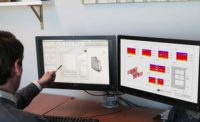Few firms in the risk-averse world of commercial contracting are willing to invest heavily in developing their own project-delivery software and even fewer opt to share those innovations with peers and competitors.
But that is precisely what the leaders at PCL Construction Services Inc. decided to do with the company’s new PartsLab software. It’s a bold business strategy that is raising eyebrows across the industry.
PartsLab is an Autodesk Revit add-in that PCL officials say will revolutionize the way the industry creates and manages construction documentation. The software is a native Autodesk Revit feature that is designed to improve collaboration among project teams and diminish downstream re-creation of models by field staff.
Specifically, it automates the creation, visualization and change management of Revit Parts—normally a manual process—by drastically reducing the time needed to create those parts, which can number in the thousands. The goal is to reduce rework and speed up schedules. PCL is offering free downloads of PartsLab and encouraging detailed feedback from its users.
It is too soon to evaluate the technical success of the software, but its launch has been nuanced and complex. “It was not an easy decision to move forward [with it],” says PCL Construction Services President Deron Brown. “But it was the right decision. We want to make things easier for workers in the field, to improve collaboration. The industry needs to connect those dots.”
The technical team at PCL Construction, led by virtual construction manager Nick Kurth, partnered with Autodesk on research and development. “Our intent is to enable an entire workforce to leverage the [virtual] model,” Kurth says. “We wanted to repurpose it for actual field layout and installation.”
PartsLab removes from the equation the need to be a sophisticated modeler and allows field personnel, including subs, to make changes to the BIM model themselves, Kurth says. The R&D phase was almost a “crowdsourcing effort,” he adds. “We leaned heavily on our experts in the field. They walked us through their workflow, and we had to figure out how to optimize those efficiencies. It has to come from there first.”
Executive-level buy-in is paramount in efforts such as this, Kurth says, along with patience and a high tolerance for mistakes. After the company began using Revit Parts, it took nearly two years to develop PartsLab, and the R&D process went through multiple iterations. “Your execs really have to want to raise the bar,” he says.
“We felt the product would eventually be a success.”
– Cathy Orquiola, Director of Corporate Development, PCL
In addition, the financial commitment can be substantial. PCL leaders won’t say how much the company has spent on R&D costs, but the catalyst for technological change arose as the industry was emerging from the recession—a time when most firms’ revenues were down, including PCL’s.
“The request for a bigger R&D budget back then was a hard pill to swallow,” Brown says. “It’s hard to put progress in terms of dollars where technology is concerned. And there’s always the possibility that we would expose ourselves to other risks, as well. But we believe that businesses have to take a more proactive approach in their industry to help champion change.”
There is some hard evidence of results from the firm’s virtual push. PCL says the company’s recent cost of rework, measured by its quality-incident reports, has been cut by 65% on average since 2011.
“The biggest hurdle was that we are not a software company. We’re a contractor,” says Cathy Orquiola, director of corporate development at PCL. Some of the firm’s leadership were uneasy about working in a new arena. But PCL has developed a corporate culture “that doesn’t see failure as a bad thing. We felt the product would eventually be a success and help raise the bar for the entire industry,” she adds.
Orquiola says the PartsLab software is complex, but firms with a general understanding of Revit should be able to use it efficiently. Most of the development was done by PCL’s in-house team, which worked closely with the field because the software is designed to be jobsite-friendly. “It was both a top-down and bottom-up scenario,” Orquiola notes. “It was vetted carefully at every step.”
“It’s a very selfless thing for PCL and Deron Brown to be offering this as a free service and not as a piece of intellectual property,” says William P. Nassal, a partner in The Nassal Co., Orlando, Fla. His firm works as a fabricator for theme parks, zoos and other entertainment venues around the world and has collaborated with PCL on several theme-park projects. Nassal says the entrepreneurial rewards of the PartsLab launch will likely outweigh its risks.
PartsLab is a featured app in the Autodesk store and has exceeded its goals for early use. PCL made the software available on Oct. 4. Kurtz anticipated 100 downloads in the first year. There were 340 downloads as of January, and “we expect that number to rise,” he says.





Post a comment to this article
Report Abusive Comment